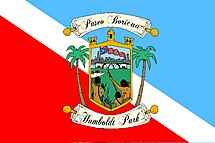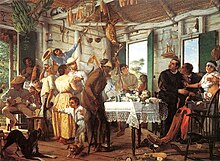|
Puerto Ricans in Chicago
 Puerto Ricans in Chicago are individuals residing in Chicago with ancestral ties to the island of Puerto Rico. Over more than seventy years, they have made significant contributions to the economic, social, and cultural fabric of the city. As of 2023, there are 206,682 residents of the Chicago metropolitan area with Puerto Rican heritage, making it the fifth largest metropolitan Puerto Rican community in the mainland US following New York, Orlando, Philadelphia, and Miami, and just ahead of Tampa.[1] HistoryThe history of the Puerto Rican community in Chicago spans over 70 years. The initial migration in the 1930s was not directly from Puerto Rico but from New York City, with many settling on State Street near downtown hotels. However, the number of individuals joining this migration was relatively small. A significant wave of migration occurred in the late 1940s,[2] primarily settling in the La Clark neighborhood north of downtown Chicago around Dearborn, La Salle, and Clark Streets. These migrants were recruited as low-wage, non-union foundry workers and domestic workers by companies like Castle Barton Associates. As initial migrants established themselves in Chicago, many were joined by their spouses and families.[citation needed] The construction of the Kennedy Expressway in the late 1950s divided the Puerto Rican neighborhoods of Wicker Park and Lincoln, which were previously one unified neighborhood. In the 1960s, urban redevelopment displaced the Puerto Rican community in Chicago, leading them to move to areas like Old Town, Lincoln Park, Lakeview, Wicker Park, West Town, and Humboldt Park on the city's West Side. They initially settled in Lincoln Park,[3] but as city-sponsored gentrification took place in the area, the Puerto Rican community moved further north and west. Settlement also occurred in Lawndale on the West Side. The Division Street riots, which took place from June 12 to 14, 1966,[4] marked a significant urban rebellion by the Puerto Rican community in Chicago. These events coincided with the Chicago Police Department's implementation of precautionary measures to prevent unrest similar to what had happened in African American centers such as Harlem, Watts, and North Philadelphia.[citation needed] In 1977, there was another conflict between the Puerto Rican community and the Chicago Police Department during the Humboldt Park riot.[5]
Present The Puerto Rican community in Chicago is known for its established presence and political activism. With the community's support, Puerto Rican leaders in Chicago secured a lease for the historic Humboldt Park stables near Paseo Boricua, which now house the Institute of Puerto Rican Arts and Culture.[10] Renovation efforts for the building involved approximately $3.4 million for the exterior and an additional $3.2 million for the interior in 2006.[11] The Puerto Rican Arts Alliance has also experienced growth and expanded to a second location in Avondale, occupying a former firehouse at the intersection of Central Park and Elbridge Avenues. Based on the 2020 census, the total number of individuals with full or partial Puerto Rican descent in Chicago was 93,193, accounting for 3.3% of the city's population.[12] This figure represents a decrease from the 102,703 recorded in 2010.[6] A majority of Puerto Ricans in Illinois (53%) now reside outside of Chicago, with 109,351 individuals living in other areas of the state out of a total population of 207,109.[13] The decline of the Puerto Rican community in Chicago can be attributed to various factors, including:
Within Chicago, the remaining Puerto Rican community is primarily concentrated on the northwest side of the city. The largest numbers of Puerto Ricans can be found in the community areas of Humboldt Park, Logan Square, Hermosa, Avondale, Austin, Belmont Cragin, Portage Park, and West Town, with Humboldt Park serving as the cultural and commercial center.[15][16] Areas immediately north and west of Humboldt Park have the highest concentrations of Puerto Ricans in the Chicago area, according to the 2020 Census. Significant Puerto Rican populations are also present in suburban areas of Chicago, including Berwyn, Waukegan, Aurora, Cicero, and Elgin.[6] Paseo Boricua
  Paseo Boricua, situated on Division Street in the East Humboldt Park section of the West Town neighborhood,[17] is a street section on the West Side of Chicago that represents the Puerto Rican community.[18][19] It spans between Western Avenue and California Avenue. Paseo Boricua is recognized as the only officially designated Puerto Rican neighborhood in the United States,[20] distinguishing it from New York City, which lacks such a designated area. The prominent features of Paseo Boricua include two fifty-nine-foot-tall steel Puerto Rican flags that serve as gateways, flanking the street.[21][22] Many businesses in the area are named after Puerto Rican towns. The street itself is dedicated to showcasing Puerto Rican pride and features a walk of fame honoring notable Puerto Ricans. Humboldt Park's Paseo Boricua neighborhood holds significance as the flagship Puerto Rican enclave and serves as the political and cultural hub of the Puerto Rican community in the Midwest. Over time, Paseo Boricua has evolved into a place where Puerto Ricans can explore and connect with their heritage. A culture center has been established, and local Puerto Rican politicians have relocated their offices to Division Street. The City of Chicago has also allocated funds to support the restoration of building facades along Paseo Boricua.[23] Visitors to Paseo Boricua can immerse themselves in the vibrant atmosphere, with salsa, reggaeton, bomba, plena, and merengue music resonating through the streets and the enticing aroma of carne guisada puertorriqueña filling the air. Some grocers in the area specialize in providing hard-to-find products from Puerto Rico, such as gandules verde, sazón, and naranja agria. The visual appeal of Paseo Boricua is enhanced by numerous colorful and historically significant murals. Additionally, two affordable housing buildings[24] with facades designed to mimic the Spanish colonial styles of Old San Juan contribute to the area's distinctive appearance.[citation needed] Near the high school named after Puerto Rican baseball slugger Roberto Clemente, there is a tile mosaic honoring him. In June 2024, the part of the Humboldt Park neighborhood in Chicago known as Puerto Rico Town or Paseo Boricua officially changed its name to Barrio Borikén.[25] Puerto Rican ParadeThe Puerto Rican Parade Committee of Chicago has been actively involved in serving the community for more than 40 years. Currently in its 48th year, the festival held in Humboldt Park has grown to become the largest Latino festival in both the city of Chicago and the Midwest, attracting a significant number of attendees. Education and economy According to Gina M. Pérez, the author of "The Near Northwest Side Story: Migration, Displacement, and Puerto Rican Families," Roberto Clemente Community Academy in Chicago is commonly referred to as "the Puerto Rican high school."[26] In Jennifer Domino Rudolph's book, "Embodying Latino Masculinities: Producing Masculatinidad," she states that the school is strongly associated with Puerto Rican cultural nationalism.[27] Ana Y. Ramos-Zayas, the author of "National Performances: The Politics of Class, Race, and Space in Puerto Rican Chicago," mentions that the media has portrayed the school as "the property of Puerto Rican nationalists" and as being connected to Puerto Rico.[28] As of 2023, only 22.6% of Chicagoland Puerto Ricans had attained a bachelor's degree or higher, though this was slightly higher than the average rate of 19.7% across all Latinos.[1] Chicagoland employed Puerto Ricans over the age of 16 were most commonly employed in Management, business, science, and arts occupations (34.1%), followed by Sales and office occupations (24.1%) and Service occupations (19.7%).[1] The median income among Chicago area Puerto Rican household was $65,459, lower than the $78,085 median among all Latinos.[1] See also
Gallery
Notes
References
Further reading
External links |









